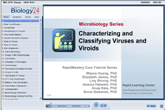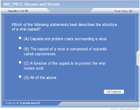| How to Learn in 24 Hours? |
|
| Need Help? |
M-F: 9am-5pm(PST):
Toll-Free: (877) RAPID-10
or 1-877-727-4310
24/7 Online Technical Support:
The Rapid Support Center
vip@rapidlearningcenter.com
Secure Online Order:

|
| Tell-A-Friend: |
Have friends taking science and math courses too? Tell them about our rapid learning system.
|
|
Viruses and Other Non-living Infectious Agents
| Topic Review on "Title": |
- A virus is an acellular agent that is infectious, it is small and has one or many pieces of nucleic acid. It can infect humans, animals, plants and bacteria and cause disease. Viruses have a much simpler structure then a bacteria. They do not have cell membranes and are made up of only a few organic molecules. Viruses and viroids do not carry out metabolism, such as transport of nutrients across a cell membrane.
- The major viral characteristics: type of genetic material (DNA or RNA, single or double stranded), viral size, capsid structure and target host are used to determine how best to classify a virus.
- Viral genomes can be linear, one piece or several molecules of nucleic acid (similar to eukaryotic chromosomes).
- Not all viruses are as specific to a host (although most are). Some can infect many different hosts and different tissues within a host. An example of a “generalist” virus is rabies. Rabies can infect many different mammals from humans to dogs to bats.
- Viruses have three basic capsid shapes: helical, polyhedral and complex.
- An envelope surrounds certain viruses. Enveloped viruses acquire their envelope from the host cell during viral replication or when the viral is released from the cell.
- A virion without an envelope is called a nonenveloped or naked virion.
|
| Rapid Study Kit for "Title": |
| Flash Movie |
Flash Game |
Flash Card |
| Core Concept Tutorial |
Problem Solving Drill |
Review Cheat Sheet |
 |
 |
 |
|
| "Title" Tutorial Summary : |
Structural characteristics of viruses and viroids and their classification are introduced. The viral genome, its structure and mechanisms of replication are presented in a step by step layout. The role of viruses in diseases and cancer are described. Finally how viruses are grown and their use in research are presented.
|
| Tutorial Features: |
Specific Tutorial Features:
- Step by step animated description of lytic and lysogenic viral replication.
- Viral replication mechanisms which include using the hosts DNA and RNA replication enzymes to copy and package viral genomes are described.
- The role of retroviruses in disease and cancer are presented.
- The effect that viruses have on the host genome and cell viability are discussed.
Series Features:
- Concept map showing inter-connections of new concepts in this tutorial and those previously introduced.
- Definition slides introduce terms as they are needed.
- Visual representation of concepts
- Animated examples—of concepts are used to step wise breakdown a concepts.
- A concise summary is given at the conclusion of the tutorial.
|
| "Title" Topic List: |
Definition of a virus and Viroid.
Step by step description of viral replication by “Lytic Replication” and “Lysogenic Replication”.
Viral genome is ether DNA, RNA, double or single stranded.
Viruses are usually specific for their host’s cells. That means a virus that attaches to lung tissue will typically not attach to nervous tissue.
Classification of viruses.
Viral genome structure.
The role of viruses in diseases and cancer.
Growing viruses in the laboratory.
Viroid: characteristics and pathology.
|
See all 24 lessons in Anatomy and Physiology, including concept tutorials, problem drills and cheat sheets:
Teach Yourself Microbiology Visually in 24 Hours
|



